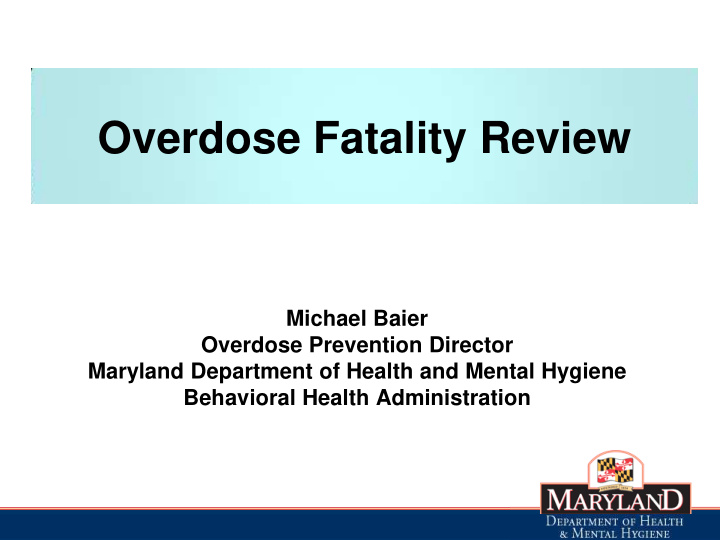



Overdose Fatality Review Michael Baier Overdose Prevention Director Maryland Department of Health and Mental Hygiene Behavioral Health Administration
OFR Overview • Modeled after existing mortality review programs (CFR, FIMR, etc.) • Multi-agency/multi-disciplinary team assembled at jurisdiction level to conduct confidential reviews of resident overdose deaths • Goal to prevent future deaths by Identifying missed opportunities for prevention and gaps in system Building working relationships b/t local stakeholders on OD prevention Recommending policies, programs, laws, etc. to prevent OD deaths Informing local overdose & opioid misuse prevention strategy • Goal NOT to initiate/extend investigation of past deaths by any particular state or local authority • Establishing trust among team members and in review process is essential to fostering open and candid discussion
LOFRT Membership No uniform requirements, but could include: • Local health department • Behavioral health treatment & recovery service providers • Local police/sheriff • EMS • Hospitals • Prosecutors • Social Services • Corrections/P&P • School system • Homeless services • Harm reduction services • Pharmacy • Other subject matter experts
DHMH/LOFRT Data Process Office of Chief Medical Examiner: monthly OD death record query: • Decedent info (name, DOB, sex, address, etc.) • Incident info (COD & MOD, location) • ME investigative notes (LE, witness, kin info) • Toxicology results Vital Statistics Administration: analyze & code OCME records for substances/classes, matches against death certificates Behavioral Health Administration: • Matches death records w/ SUD Tx records • Compiles all data in secure file & sends to LOFRTs quarterly • LOFRT Data Use Manual • Technical assistance LOFRT: Team members must query agency systems for decedent info and bring to meetings to inform review
OFR Implementation Timeline • Nov. 2012: Review of DHMH/LHD legal authority to establish OFR teams • Mar. 2013: BHA solicits volunteer LHDs to pilot LOFRTs (Balt. City, Cecil, Wicomico) • Jun. 2013: BHA provides pilots w/ program documentation • Sept. 2013: BHA receives US DOJ Harold Rogers PDMP grant to fund pilots • Oct-Dec 2013: pilot sites finalize membership • Dec. 2013: BHA hires OFR coordinator • Feb. 2014: first meetings held • May 2014: OFR law (HB1282) passes; effective 10/1/14
HB1282, 2014 • Allows, but does not require, jurisdictions to establish LOFRTs • Provides direction on team structure and operations (membership, goals, etc.) • Requires healthcare providers & gov. agencies to provide records on request from team chair • Civil liability protection for team members and those that provide information • Confidentiality requirements (public & closed mtgs.) • Establishes DHMH oversight and team reporting requirements
OFR Current Status • 15 operational teams Allegany Carroll Prince George’s Anne Arundel Cecil Somerset Baltimore City Frederick Washington Baltimore Garrett Wicomico Caroline Harford Worcester • Estimate nearly 200 cases reviewed • LOFRTs provide BHA w/ case review stats, mtg. notes incl. observations & trends • BHA attends team mtgs., T/A through quarterly conference calls
Pilot Phase Operations 86 total cases reviewed Jan. – Oct. 2014 Unknow <18 18-24 25-34 35-44 45-54 55-64 65+ n Total Gender Male 0 5 15 12 16 11 3 0 62 72% Female 0 1 8 5 5 3 1 1 24 28% Race/Ethnicity African American 0 2 5 3 7 5 1 0 23 Hispanic 0 0 1 0 1 0 0 0 2 White 0 4 16 13 13 9 2 1 58 Unknown 0 0 1 1 0 0 1 0 3
Agency Data Available 1 1 VA Hospital 56 65% Emergency Medical Services 76 88% Law Enforcement 11 13% Detention Center (Jail) 8 9% Court System 22 26% Mental Health Treatment 31 36% Social Services 25 29% Community Supervision 29 34% State's Attorney 10 12% Syringe Exchange Program 4 5% Pharmacy 49 57% Drug Treatment (Public and Private) 9 10% Hospital
Notable LOFRT Observations • Large number of decedent contact with systems – Heavy social service system involvement – Heavy criminal justice system involvement in Balt City • Wicomico: heroin & Rx deaths among professionals w/ no system contact history • Alcohol often involved in overdose deaths • Older drug users at high risk, with many co- occurring chronic health issues • Care coordination in somatic health and addiction treatment needs improvement • Occurrence of trauma just before death (loss of a loved one, struggles with child custody, etc.)
Observations ctd. • Deaths occurring in private locations, incl. at home & in hotels/motels • Recent release from jail; detoxification in jail system before release • History of intimate partner violence • Poly-pharmacy • Previous overdose • Pain management • Hispanic population and LGBT
LOFRT Outcomes to Date • Improved the quality of referral system • More direct outreach to families to provide overdose prevention & treatment services • Agencies refer clients to Overdose Response Program (naloxone) trainings and have agency staff trained • Educated and increased the awareness of staff of overdose related issues – Promoting substance use disorder education and assessment at all levels of the organization • Outreach to Veterans Affairs to improve information sharing • Changes to intake questionnaires to include questions about overdose history
Questions? Michael Baier Overdose Prevention Director Maryland Department of Health and Mental Hygiene Behavioral Health Administration michael.baier@maryland.gov 410-402-8643
Recommend
More recommend